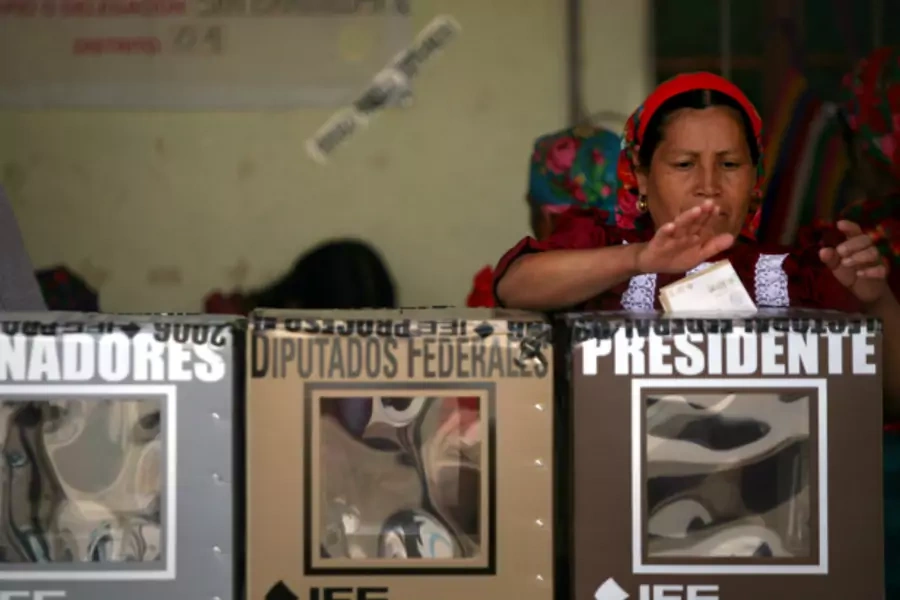More on:
View article in Spanish, originally published in El Financiero.
Mexico’s presidential elections for decades have been a one shot deal. Whomever wins the most votes—paltry as that count may be—goes on to live in Los Pinos. And paltry they increasingly are -- in the last two elections these numbers dipped well below 40 percent; in 2018 many believe the winner could garner less than a third of the ballots. This has significant negative ramifications for legitimacy, accountability, and governability. But there is a solution – a second electoral round.
Most of Latin American and indeed most countries around that world that elect presidents, as opposed to prime ministers, have a second round. A few weeks or so after the first election voters return to the ballot box to choose between the two highest vote getters. This process ensures the new president an electoral mandate, as by definition over half of the voters chose the winner in the second round. This is vital for leaders, such as Argentina’s president Mauricio Macri, who want to make big changes to the status quo.
Second rounds also tend to eliminate extreme or fringe candidates, exposing the very real electoral ceiling on their vote share beyond the fervently loyal. This is the immediate reason many in Mexico champion the reform, as they believe it will stop a 2018 AMLO victory.
A two round system lends itself to political bargaining– with the two top contenders assiduously courting the runners up and their votes. This at times makes strange bedfellows – for instance recently in Peru, when the left and right of the political spectrum galvanized around former banker turned politician Pedro Pablo Kuczynski (PPK) to defeat the initial front runner, Keiko Fujimori.
Runoffs of course have their limits. While the president has a more robust mandate, they often face a divided congress, which can lead to gridlock. And because two people can win in the first round, it encourages more candidates to run, leading to a proliferation of political parties and the problems therein. But Mexico’s other electoral rules—namely the combination of single member districts, where just one person wins a senate or congressional race, and the plurinominales, where party leaders’ choose who makes the longer proportional representation list —will head off a more Brazilian fate (at least in terms of the number of political parties).
What a second round will help Mexico deal with is the longer term political fracturing already under way. This is due both to changing social mores and the rise of independent candidates.
Mexican voters no longer identify as they once did with the traditional parties. As recently as the turn of the 21st century, nearly 3 out of 4 voters identified with one of the main political parties: PRI, PAN, or PRD. Today, just half of the electorate declares any allegiance to an identifiable party. The young and educated in particular don’t commit, shifting with candidates or splitting their tickets between parties. With the new generations of voters increasingly unmoored from the lifelong identifications of the past, politicians have growing incentives to differentiate themselves from the party masses.
Add to this the new legal framework for independent candidates. While the recent reforms allowing these mavericks are a win for representation, it further fragments the political scene. Looking toward the 2018 presidential race, Mexico could see five or more options on the ballot, particularly if a few of those vying for a traditional party nomination make good on their threats to go it alone if not chosen. And even if their appeal remains quixotically in the single digits, the inherent dispersion among so many choices will weaken the election’s winner by granting him or her just a fraction of the popular vote.
President Peña Nieto has come out against instituting a second round in Mexico’s electoral system, saying that the majorities such rules create are “fictitious.” Yet fictions can serve a purpose -- building trust among politicians and with society, and forming a programmatic basis for political coalitions.
Peña’s opposition likely results from other reasons. The president may believe the PRI’s famous “hard vote” is still enough to win the 2018 contest. If the PAN fractures or if El Bronco or other independents jump in, then with even less than 30 percent of the vote the PRI candidate could in fact squeak by—though at the cost of legitimacy and governability. But perhaps the president’s real worry is as he looks around the table, the most likely second round coalition—between the PAN and PRD—would exclude him and his chosen successor. And that is something a PRI president can’t abide. Yet if these short term partisan preferences win out, Mexico will lose.
True, a second round won’t solve all of the nation’s ills. But it will help shift away from an imperial presidency to one where power comes from an electoral mandate. This would give the next president the citizen’s backing to deal firmly with a potentially erratic northern neighbor. And most importantly, it could galvanize Mexico’s political system to finally implement the desperately needed changes to improve security, better education, and increase long term investment, making its economy competitive for the twenty-first century in ways that will benefit society more broadly.
More on:
 Online Store
Online Store
